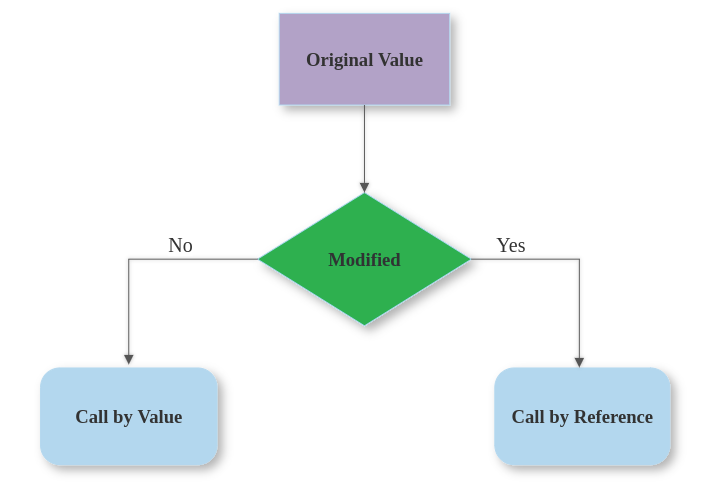In JavaScript, a variable may store two types of values, Primitive values or Reference values. This article will describe and help to compare both these types of values

Call by value
When a variable is passed by value, a copy of the variable’s value is passed to the function or method. Any changes made to the variable within the function or method do not affect the original variable outside of it. In JavaScript, primitive data types (such as numbers, strings, and booleans) are passed by value.
const addFunc=(x)=>{
console.log( x +10);
}
addFunc(5) // print 15
let y=10;
addFunc(y) //print 20
console.log(y) //prints 10
Call by reference
When a variable is passed by reference, a reference to the memory location of the variable is passed to the function or method. Any changes made to the variable within the function or method are reflected in the original variable outside of it. In JavaScript, objects and arrays are passed by reference.

Example
let num = 5;
let obj = {a: 1);
function changeValue(val) (
val = 10;
function change0bj(o) {
o.a = 2;
}
changeValue(num);
console. log(num); // still prints 5
change0bj(obj);
console. log(obj.a); // prints 2
It’s important to keep in mind that when passing an object or array to a function and modifying it within the function, the original object or array is also modified. This can lead to unexpected behavior if not handled properly.
As a best practice, it’s a good idea to create a copy of an object or array before passing it to a function if you do not want the original to be modified.
Example
There are several ways to copy an object or array before passing it to a function.
- For Array
let originalArray = [1, 2, 3];
// copied Arrays
let copiedArray1 = originalArray.slice();
let copiedArray2 = [].concat(originalArray);
let copiedArray3 = [...originalArray];
- For Object
let originalObj = {a: 1};
// copied Objects
let copiedObj1 = Object.assign({}, originalObj);
let copiedObj2 = {...originalObj};
let copiedObj3 = JSON.parse(JSON.stringify(originalObj));
Few Puzzles
Puzzle 1
What would be the value of a and b?
a = {z:10,x:20}
b =[{...a}]
b[0].z=20;
console.log(`a=${a}`)
console.log(`b=${b}`)
Answer
a ={z : 10, x : 20} , b= [ { z : 20, x : 20 } ]
Here the spread operator ( … ) copies the array. so change done to b is only effected in b.
Puzzle 2
What would be the result of the following consoles?
let a = [{z:10}];
let b = [...a];
// b=[{z:10}]
b[0].z =100;
// Part 1
console.log(`a=${a}`)
console.log(`b=${b}`)
//Part 2
b.push(40)
console.log(`a=${a}`)
console.log(`b=${b}`)
//Part 3
let c = [{...a[0]}];
c[0].z=300;
console.log(`a=${a}`)
console.log(`c=${c}`)
Part 1 Answer
a= [ { z : 100 } ] , b= [ { z : 100 } ]
Part 2 Answer
a = [ { z : 100 } ] , b = [ { z :100 } ,40]
In the code, an array a is created with an object {z: 10}. A shallow copy of a is created and assigned to b using the spread operator ( … ). When b[0].z is set to 100, the change is reflected in both a and b since it’s just a shallow copy. Adding an element to b (b.push(40)) only affects b and does not reflect in a.
Part 3 Answer
a = [ { z : 100 } ] , c = [ { z : 300 } ]
A shallow copy in JavaScript is a way of creating a new object that has the same properties as an existing object, but the properties themselves are not duplicated. Instead, the new object will reference the same values as the original object. It means that if the original object has any nested objects or arrays, the shallow copy will have references to the same nested objects and arrays, but not have new copies of them. This means that any changes made to the nested objects or arrays in the copied object will also be reflected in the original object.
In this article, we covered some weird cases of reference variables in javascript. Hope this is helpful and fun. Try it for yourself!
Thanks for reading, and happy coding!